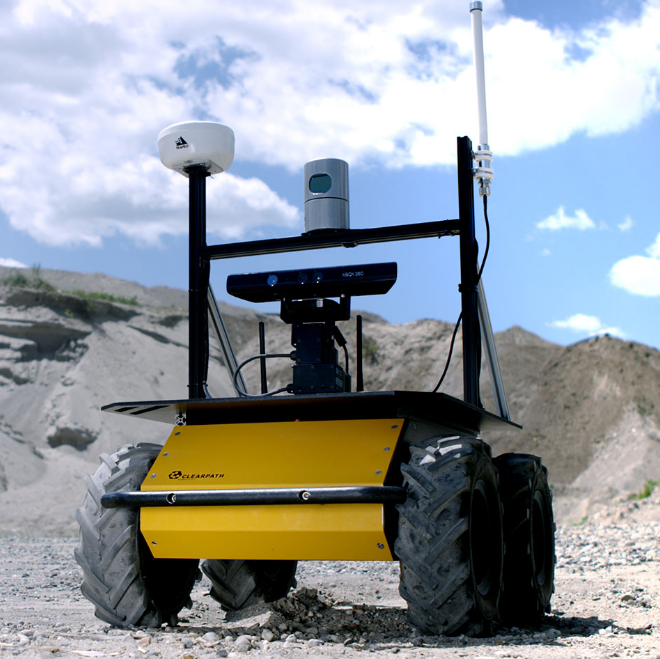laser_scan_matcher是一个增量式的scan配准工具. 在连续的sensor_msgs/LaserScan消息之间进行scan match, 把laser的估计位姿以geometry_msgs/Pose2D消息发布,产生tf变换。
激光里程计可以不需要轮式里程计和IMU,也可以使用二者加快配准速度。可接受sensor_msgs/LaserScan或者sensor_msgs/PointCloud2消息
当每次新的scan产生时(每次进入scan的回调函数时),如果为传感器当前的位姿提供初值(使用轮式里程计和IMU),可以加快PL-ICP的配准速度。如果没有初值,则使用零速度模型。 源码在getPrediction函数,在delta_t时间内的相对运动x, y用轮式里程计的delta_x和delta_y表示。 如果用了IMU,delta_theta用IMU的相对yaw表示,否则还用轮式里程计。
包里的demo.bag是手持一个Hokuyo雷达的移动结果,当然没有里程计。
常数速度模型: 假设机器人基于估计的速度运行,速度估计来自传感器或 derivating and filtering scan match的结果. 需要的话题是vel. 使用Alpha-beta滤波器 tracking scan-matching 的预测值
零速度模型: 不使用预测,假设机器人停在原地。
我们可以使用轮式里程计+IMU,或者 IMU+alpha-beta tracking。 使用的优先级是:IMU > Odometry > Constant Velocity > Zero Velocity. 源码在getPrediction函数
IMU和轮式里程计(尤其IMU)可以显著提高收敛速度, 强烈建议添加IMU
scan matcher性能稳定时, Alpha-beta tracking 也可以加速收敛,但可能在动态变化环境或缺少特征的环境下出现weird behavior, 一般建议开启,出现异常再关闭。
Keyframes 和 frame-to-frame scan matching
激光里程计一般是frame-to-frame,每一帧scan和上一帧配准. scan中的噪声是难免的,即使机器人不动, incremental 变换也不是零,机器人位姿会慢慢漂移。
可以使用keyframe-based matching. 位姿变换是在当前scan 和 keyframe scan之间计算. keyframe scan只有在机器人移动一定距离后才更新,如果机器人不动,keyframe scan不变,位姿就不会漂移。 参数kf_dist_linear和kf_dist_angular(弧度制)作为阈值。 把两个阈值都改为0,就可以切换回frame-to-frame模式
话题和tf
订阅:
- scan (sensor_msgs/LaserScan) Scans from a laser range-finder
- cloud (sensor_msgs/PointCloud2) Scans in point cloud form
- imu/data (sensor_msgs/Imu) 用于 theta prediction. 只有参数
use_imu为true才有效 - odom (nav_msgs/Odometry) 用于x-, y-的预测, 没有IMU时预测theta. 只有参数
use_odom为true才有效
发布:
pose2D (geometry_msgs/Pose2D) The pose of the base frame, in some fixed (world) frame
需要的tf: base_link——laser, the pose of the laser in the base frame.
提供的tf: world——base_link, the pose of the robot base in the world frame. Only provided when
publish_tfis enabled. world可以改为自定义的名称,一般为odom
参数
~fixed_frame(string, default: “world”): the fixed frame,可以改为odom~base_frame(string, default: “base_link”): the base frame of the robot~use_imu(bool, default: true) Whether to use an imu for the theta prediction of the scan registration. Requires input on/imu/datatopic.~use_odom(bool, default: true) Whether to use wheel odometry for the x-, y-, and theta prediction of the scan registration. Requires input on odom topic.~use_vel(bool, default: false) Whether to use constant velocity model for the x-, y-, and theta prediction of the scan registration. Requires input on vel topic.
在小强机器人的使用
注释StatusPublisher.cpp的部分代码,也就是屏蔽原来的odom:1
2
3
4
5mOdomPub = mNH.advertise<nav_msgs::Odometry>("xqserial_server/Odom", 1, true);
mOdomPub.publish(CarOdom);
br.sendTransform(tf::StampedTransform(transform, current_time.fromSec(base_time_), "odom", "base_footprint"));
注释xqserial.launch下面部分,因为我们的目的是odom-->base_link,目前base_footprint是link的parent了,base_link不能有两个parent:1
<node pkg="tf" type="static_transform_publisher" name="baselink_broadcaster" args="0 0 0.15 0 0 0 1 base_footprint base_link 50">
编辑laser_scan_matcher中的rplidar.launch:1
2
3
4
5
6
7
8
9
10
11
12
13
14
15
16
17<launch>
<include file="$(find rplidar_ros)/launch/a2.launch" />
<node pkg="laser_scan_matcher" type="laser_scan_matcher_node"
name="laser_scan_matcher_node" output="screen">
<param name="publish_tf" value = "true" />
<param name="fixed_frame" value = "odom"/>
<param name="max_iterations" value="10"/>
<param name="publish_pose_with_covariance_stamped" value="true" />
<param name="publish_pose" value="false" />
<param name="do_compute_covariance" value="false" />
<param name="kf_dist_linear" value="0.08" />
<param name="kf_dist_angular" value="0.14" />
<remap from="/imu/data" to="/xqserial_server/IMU" />
<remap from="pose_with_covariance_stamped" to="plicp_pose" />
</node>
</launch>
启动startup, roslaunch laser_scan_matcher rplidar.launch. 现在原来的轮式坐标系odom坐标系换成了 激光坐标系 odom
现在tf变换是: odom —-> base_link —-> laser
问题

